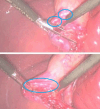Visual cues of soft-tissue behaviour in minimal-invasive and robotic surgery
- PMID: 39508918
- PMCID: PMC11543711
- DOI: 10.1007/s11701-024-02150-y
Visual cues of soft-tissue behaviour in minimal-invasive and robotic surgery
Abstract
Minimal-invasive surgery (MIS) and robotic surgery (RS) offer multiple advantages over open surgery (Vajsbaher et al. in Cogn Syst Res 64:08, 2020). However, the lack of haptic feedback is still a limitation. Surgeons learn to adapt to this lack of haptic feedback using visual cues to make judgements about tissue deformation. Experienced robotic surgeons use the visual interpretation of tissue as a surrogate for tactile feedback. The aim of this review is to identify the visual cues that are consciously or unconsciously used by expert surgeons to manipulate soft tissue safely during Minimally Invasive Surgery (MIS) and Robotic Surgery (RS). We have conducted a comprehensive literature review with papers on visual cue identification and their application in education, as well as skill assessment and surgeon performance measurement with respect to visual feedback. To visualise our results, we provide an overview of the state-of-the-art in the form of a matrix across identified research features, where papers are clustered and grouped in a comparative way. The clustering of the papers showed explicitly that state-of-the-art research does not in particular study the direct effects of visual cues in relation to the manipulation of the tissue and training for that purpose, but is more concentrated on tissue identification. We identified a gap in the literature about the use of visual cues for educational design solutions, that aid the training of soft-tissue manipulation in MIS and in RS. There appears to be a need RS education to make visual cue identification more accessible and set it in the context of manipulation tasks.
Keywords: Visual cues in surgery; Visual cues in surgical education; Visual feedback in robotic surgery.
© 2024. Crown.
Conflict of interest statement
Robin Julia Trute, Dr Afshin Alijani and Dr Mustafa Suphi Erden have no conflicts of interest or financial ties to disclose.
Figures




Similar articles
-
Evaluating tactile feedback in robotic surgery for potential clinical application using an animal model.Surg Endosc. 2016 Aug;30(8):3198-209. doi: 10.1007/s00464-015-4602-2. Epub 2015 Oct 30. Surg Endosc. 2016. PMID: 26514132 Free PMC article.
-
The Effect of Formal Robotic Residency Training on the Adoption of Minimally Invasive Surgery by Young Colorectal Surgeons.J Surg Educ. 2018 May-Jun;75(3):767-778. doi: 10.1016/j.jsurg.2017.09.006. Epub 2017 Oct 18. J Surg Educ. 2018. PMID: 29054345
-
Acoustic signal analysis of instrument-tissue interaction for minimally invasive interventions.Int J Comput Assist Radiol Surg. 2020 May;15(5):771-779. doi: 10.1007/s11548-020-02146-7. Epub 2020 Apr 22. Int J Comput Assist Radiol Surg. 2020. PMID: 32323212 Free PMC article.
-
Role of robotic surgery on pelvic floor reconstruction.Minerva Ginecol. 2019 Feb;71(1):4-17. doi: 10.23736/S0026-4784.18.04331-9. Epub 2018 Oct 11. Minerva Ginecol. 2019. PMID: 30318878 Review.
-
A review of haptic feedback in tele-operated robotic surgery.J Med Eng Technol. 2020 Jul;44(5):247-254. doi: 10.1080/03091902.2020.1772391. Epub 2020 Jun 23. J Med Eng Technol. 2020. PMID: 32573288 Review.
Cited by
-
Enhancing pediatric robotic pyeloplasty with a no-touch urothelium approach: a case series.BMC Urol. 2025 Apr 18;25(1):94. doi: 10.1186/s12894-025-01782-y. BMC Urol. 2025. PMID: 40251613 Free PMC article.
-
Role of haptic feedback technologies and novel engineering developments for surgical training and robot-assisted surgery.Front Robot AI. 2025 Jun 4;12:1567955. doi: 10.3389/frobt.2025.1567955. eCollection 2025. Front Robot AI. 2025. PMID: 40534772 Free PMC article. Review.
References
-
- Vajsbaher T, Ziemer T, Schultheis H (2020) A multi-modal approach to cognitive training and assistance in minimally invasive surgery. Cogn Syst Res 64:08
-
- LaGrange C, Clark C, Gerber E, Strup S (2008) Evaluation of three laparoscopic modalities: robotics versus three-dimensional vision laparoscopy versus standard laparoscopy. J Endourol 22:511–516 - PubMed
-
- Perkins N, Starkes JL, Lee TD, Hutchison C (2002) Learning to use minimal access surgical instruments and 2-dimensional remote visual feedback: how difficult is the task for novices? Adv Health Sci Educ Theory Pract 7(2):117–131 - PubMed
-
- Rentschler M, Dumpert J, Platt S, Ahmed S, Farritor S, Oleynikov D (2006) Mobile in vivo camera robots provide sole visual feedback for abdominal exploration and cholecystectomy. Surg Endosc 20:135–138 - PubMed
Publication types
MeSH terms
Grants and funding
LinkOut - more resources
Full Text Sources
Miscellaneous

